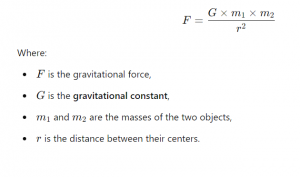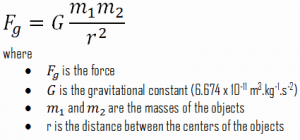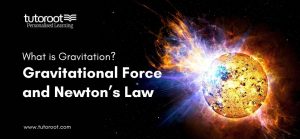What is Gravitation? Gravitational Force and Newton’s Law
Introduction to Gravitation
The universe is a fascinating expanse of mysteries, and one of the forces that governs everything within it is gravity. From the Earth orbiting the Sun to an apple falling from a tree, gravitation influences every single object with mass. But what exactly is gravity? Why do objects fall to the ground, and how did Sir Isaac Newton come up with the revolutionary idea that connected everything in the universe? In this blog, we’ll delve into the concept of gravitational force, explore Newton’s law of gravitation, and understand how these ideas shaped modern physics.
What is Gravitational Force?
Gravitational force is the attractive force that exists between any two objects with mass. Whether it’s the moon orbiting the Earth or a pen lying on a table, gravitational force is at work. The force depends on two factors: the mass of the objects and the distance between them. Simply put, the more massive an object, the stronger its gravitational pull. The farther apart two objects are, the weaker the pull becomes.
Gravitational force plays a vital role in keeping celestial bodies in motion. It is the force that binds galaxies, causes planets to orbit stars, and pulls objects toward the Earth. The force of gravity ensures that we remain grounded on the Earth’s surface.
Newton’s Law of Universal Gravitation
Sir Isaac Newton, in the 17th century, formulated a groundbreaking theory known as Newton’s law of universal gravitation. According to this law, every object in the universe attracts every other object with a force that is proportional to the product of their masses and inversely proportional to the square of the distance between them. This was a major milestone in the history of gravitational theory as it applied universally, from objects on Earth to distant stars and planets.
In simpler terms, Newton’s law explains that the gravitational force between two bodies becomes stronger as their masses increase and weaker as they move farther apart. This concept revolutionized our understanding of gravity and became the foundation of classical mechanics.
Mathematical Expression of Gravitational Force
The mathematical formula to express the gravitational force between two objects is given by:
This gravity formula accurately calculates the force of attraction between two masses, whether they are small objects on Earth or celestial bodies in space.

Gravitational Constant (G)
The gravitational constant, denoted as [Equation]G, is a universal constant that helps quantify the gravitational force. Its value is approximately:

The value of [Equation] G allows us to calculate the gravitational force between two objects, and it is a crucial part of the derivation of gravitational force. Without this constant, the applications of gravity formula would not be possible.
Factors Affecting Gravitational Force
Two key factors affect gravitational force:
- Mass of the objects: The greater the mass, the stronger the gravitational pull.
- Distance between objects: The farther apart two objects are, the weaker the gravitational attraction.
Interestingly, the gravitational force between two small objects is practically unnoticeable. However, when large celestial bodies like planets are involved, this force becomes significant. That’s why we feel the Earth’s gravity much more strongly than we do that of a nearby object, such as a book.
Applications of Newton’s Law of Gravitation
The importance of Newton’s law of gravitation cannot be overstated. It has wide-ranging applications in science and everyday life:
- Orbital Mechanics: Newton’s law explains how planets orbit the Sun, how moons orbit planets, and how artificial satellites stay in orbit around the Earth.
- Tidal Forces: The gravitational attraction between the Earth and the Moon causes ocean tides. Newton’s law helps explain this phenomenon by calculating the force between celestial bodies.
- Engineering and Construction: Gravitational force calculations are crucial in the construction of bridges, towers, and other large structures to ensure they are stable and safe.
- Astronomy: From calculating the orbits of stars to predicting the motion of galaxies, Newton’s law provides the backbone of modern astronomy.
These applications of the gravity formula help us not only understand the natural world but also innovate in fields like engineering, technology, and space exploration.
Limitations of Newton’s Law of Gravitation
While Newton’s law of gravitation revolutionized our understanding of gravity, it is not without its limitations:
- Accuracy at High Speeds and Large Distances: Newton’s law does not hold in scenarios involving very high speeds or massive gravitational fields, such as black holes.
- General Relativity: Einstein’s theory of relativity has refined our understanding of gravity, particularly at the extremes of the universe, where Newton’s law falls short.
Einstein’s General Theory of Relativity and Gravitation
Albert Einstein’s General Theory of Relativity, proposed in the early 20th century, offered a new perspective on gravity. According to Einstein, gravity is not a force in the traditional sense, but rather the result of the curvature of spacetime caused by massive objects. In this view, objects follow curved paths in spacetime due to the presence of mass.
Einstein’s theory has been tested and proven in many situations, including the bending of light around stars and the precise movement of planets. It provides a more comprehensive explanation of gravitation, especially in extreme conditions like those near black holes.
Conclusion
Gravitation is a fundamental force of nature, governing everything from the smallest particles to the largest galaxies. The concept of gravitational force and Newton’s law of gravitation laid the foundation for classical physics, enabling us to understand the movements of celestial bodies and the forces acting on objects here on Earth. Though Newton’s law has its limitations, it remains an essential tool in modern science, guiding everything from space exploration to structural engineering. And as we continue to push the boundaries of our understanding with theories like Einstein’s, gravity remains one of the most awe-inspiring forces in the universe.
If you found this explanation useful and want to learn more, don’t miss out on other great content on the Tutoroot Blog. Tutoroot provides expert Physics online Tuition that simplifies even the toughest subjects. Want to excel in your studies? Sign up for a FREE DEMO session of Tutoroot’s online home tuition and experience personalised learning designed just for you.
FAQ’s
What is gravitational force?
Gravitational force is the attractive force that exists between any two objects with mass. The strength of this force depends on the mass of the objects and the distance between them, with more massive objects exerting a stronger gravitational pull.
What does Newton’s law of universal gravitation state?
Newton’s law of universal gravitation states that every object in the universe attracts every other object with a force that is directly proportional to the product of their masses and inversely proportional to the square of the distance between them.
How is the gravitational force mathematically expressed?
The gravitational force between 2 objects is mathematically expressed using the formula:

What are the key applications of Newton’s law of gravitation?
Newton’s law of gravitation is widely applied in various fields, such as understanding planetary orbits, explaining tidal forces, calculating satellite motion, and developing modern engineering structures.
What are the limitations of Newton’s law of gravitation?
Newton’s law is less accurate in extreme conditions, such as near massive bodies like black holes or when objects move at very high speeds. Einstein’s theory of general relativity provides a more precise explanation of gravity in these scenarios.

